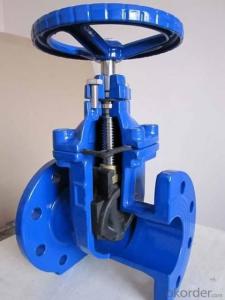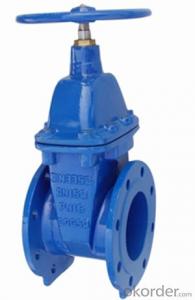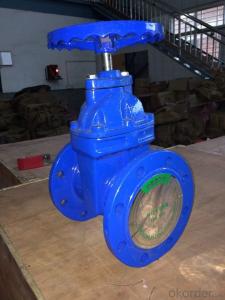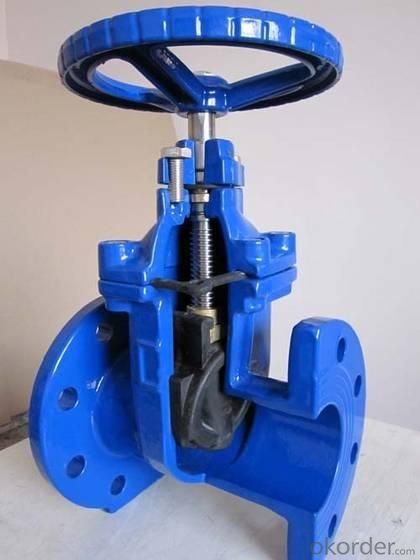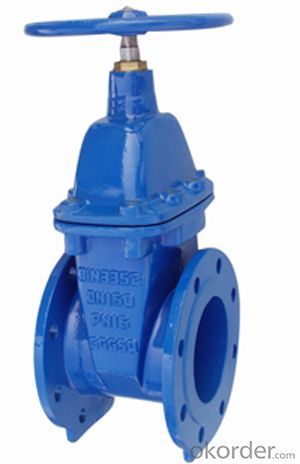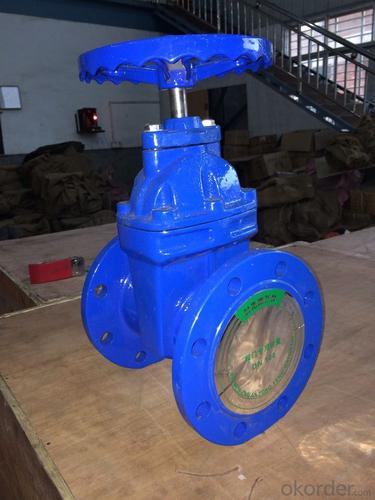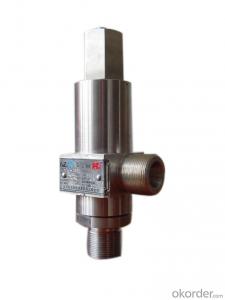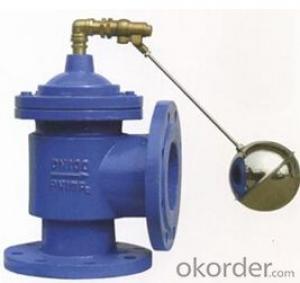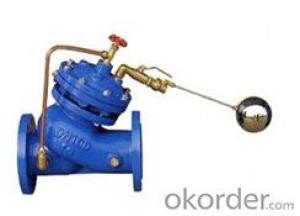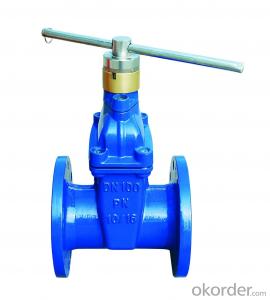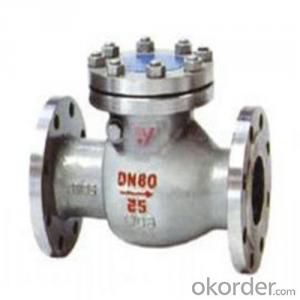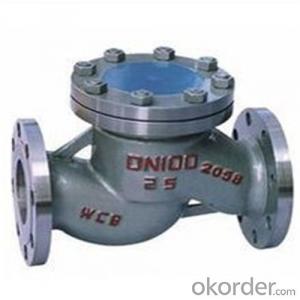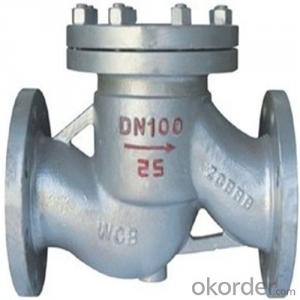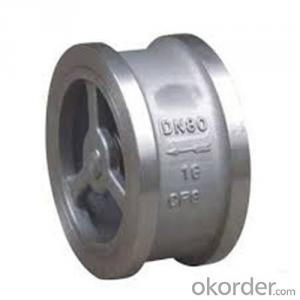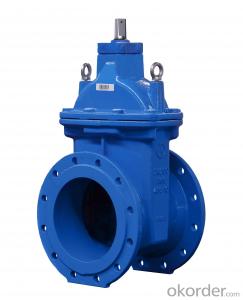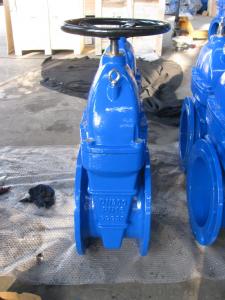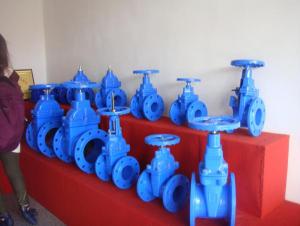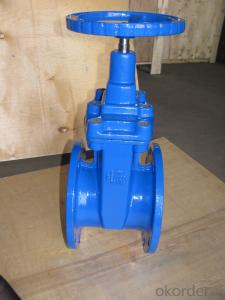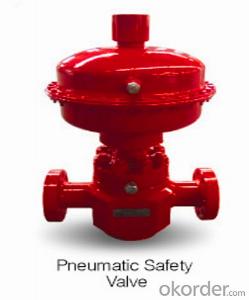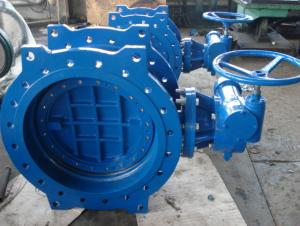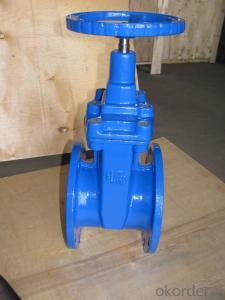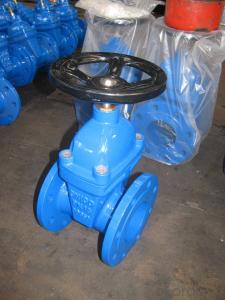Non-rising Stem Resilient Seated Gate Valve Made of Ductile Iron
- Loading Port:
- Tianjin
- Payment Terms:
- TT OR LC
- Min Order Qty:
- 100 unit
- Supply Capability:
- 100000 unit/month
OKorder Service Pledge
OKorder Financial Service
You Might Also Like
Non-rising resilient seated gate valves solve the problem in general gate valves such as leakage, rusting etc. and saves installation space. It is used widely in tap water industry, sewage treatment, shipping construction, petroleum, chemicals, food, pharmacy, textile, electric power, metallurgy and energy system's pipeline to adjust and shut off fluids.
l Replaceable O-ring
l Low torque operation
l Rubber encapsulated wedge
l Clockwise closing direction
l Fusion bonded epoxy coated inside and outside
Specification
Body materials: Ductile Iron/Metal
Design standard: DIN3352 F5/F4, according to requirements
Design pressure: PN10/PN16/PN25
Size: DN80mm-DN2000
Connect type: Flanged gate valve
Seal type: Resilient seated gate valve, EPDM+ Ductile Iron
Coating:
Fusion bonded epoxy coated both on the interior as well as the exterior surfaces of the valve, flange surfaces are also fully epoxy coated, blue color.
Application
Potable water, neutral liquids, irrigation, heating and chilled water, fire systems etc, in either above ground or buried service applications and requires minimal maintenance
Feature
This Ductile Iron Resilient Seated Gate Valve is fully compliant to DIN3352 F4. We have light weight type, heavy weight type and even middle weight type for your reference, and these three options design construction of ductile iron will offer a robust and durable extended life performance.
1- Bolted bonnet, full bore: used for larger valves and higher pressure applications.
2- Stem sealed with O-rings: realize zero leakage, could be replace under full pressure.
3- Rubber encapsulated wedge: excellent elastic memory, ensure sealing effect.
4- Blue fusion boned epoxy coated inside and outside: suitable for portable water.
5- Working pressure from -1 to +16 and working temperature from -10 to +80°C
Durable
This valve is suitable for use in a wide range of applications including potable water, neutral liquids, irrigation, heating and chilled water, fire systems etc, in either above ground or buried service applications and requires minimal maintenance. This Resilient Seated Gate Valves have a rated working pressure of 16 Bar. The valves seal 100% leak tight. The waterway is clear, unobstructed and free from pockets. Resilient seated gate valves are fusion bonded epoxy coated both on the interior as well as the exterior surfaces of the valve, flange surfaces are also fully epoxy coated.
Advantages
1- OEM Factory : Professional manufacturer, clients from whole world.
2- High Quality, Competitive Price: Custom is accepted.
3- Complete Service: Long service Life, Fast delivery, Multilingual services.
4- Certificates: ISO9001, CE, NSF, TS, WRAS.
5- Low MOQ: Ready for providing the sample and producing some small orders.
FAQ
Q: Do you produce valves with PN40?
A: Yes, but for PN40, we suggest materials of metal, like cast steel, stainless steel…etc. We could also produce ductile iron valves with PN40.
Q: Are you manufacturer or trading company? Which kind of valves do you supply?
A: We are a professional manufacturer of butterfly valves, check valve, non-return valves, gate valves, Y-strainer and so on.
Q: Will you do inspection before shipment? Whether Third Party Inspection is available?
A: We have a professional engineer team, so we can offer you the most professional technical support. All valves are tested twice before and after hammer pin to ensure its perfect sealing property and to make sure every valve is ok before ex-factory. TPI is ok but the clients should bear all fees.
Q: What kind of package do you use for these valves?
A: Valves from DN80-DN1400 will be packed in wooden boxes, but valves above DN1400 will be in wooden pallets. If you need wooden boxes for above DN1400, the price may be more expensive.
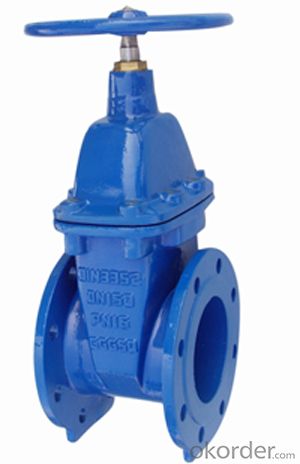
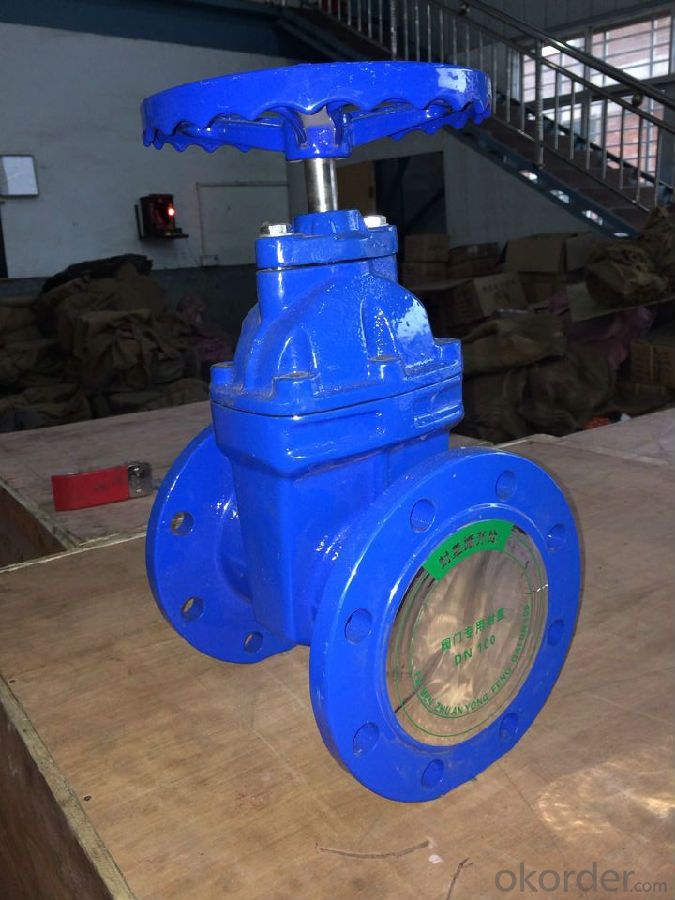
- Q: Is it posible there is underground valves? I looked all over my yard and can only find2 valves.???
- Yes, electric valves are set on the Mainline which is under pressure. Usually in a loop around the home with the valves set where the zone starts. Some are designed to have a short mainline with the valves set in a large box next to a vacuum breaker. All valves need wires that run from the clock. Sorbet can be found with a metal detector if you simply can't find them. You can also set them to go off manually time delayed a few minutes, enough to go listen to hear the valve opening.
- Q: We have a wall mounted shower head as well as a ceiling mounted shower head. Suddenly the turning valve for the wall mounted head does not work, only the ceiling one does. Is this stripped. Can it be repaired with a marble wall? I have a photo if needed. Thank you ahead of time. Patrick
- The mixing valve is in the handle that turns the water on. You don't need to take down the wall to get at it. The handle come off including any cover plate and the valve is right behind it. Be careful not drop/lose any screws or washers. They are small. The home center sells replacements for certain brands so get that information.
- Q: Hi, i bought an xr250r 2002 model. I rebuilt the engine and put in new exhaust valves. After i did this proper compression in the motor came back and it wasnt blowing smoke anymore. I took it for a 'run-in' ride, and noticed that the engine was quite noisy. I guessed it was the valves needing adjusting. I got numbers for the valve clearences which were: .004 of in inch for the exhaust valves and .005 of an inch for the air intake. Now i have done this the compression in the bike is enormous, it is barely possible to kick over, and the motor is very noisy, there is a loud ticking noise which im guessing is still the valves. Is all this normal considering i have just rebuilt the engine, put in new valves and hardly ridden (one 50km ride)? I would like to keep riding it to run it better to see if the motor loosens up, but im scared to ride it as it is. Any advice would be greatly appreciated.
- .004 is a bit tight for an exhaust valve? usually this is nearer 10 thou. It is better to have slightly larger clearances to the tappets/ valves than to be too tight and risk burning your valves. You do not mention the decompressor! I'm sure your bike should have a manual decompression lever if not an auto retard unit on the cam shaft to allow you to atleast crank the engine up to TDC on the compression stroke. I suspect that is where the noise problem is coming from, either that or you might be one tooth out on your cam shaft gear allowing the piston crown to kiss the valve when it is open...hence explaining the very hard to turn over!! but see my other comment too! What ever It is time to remove the inspection covers and re examine the whole set up. BTW the bike should be an UTTER PIG to kick over compression without a decompressor!! as it has a very high compresion ratio. expect to be standing up on the kick start if you are less than 160 lb (11 stone) 78 kg
- Q: Cylinder head valves.Can't really differentiate the difference between burnt and just carbon build up on valves. Are they the same?If I the valves have no cracks or holes, can I clean the carbon off of them and reuse them.If they don't leak when I re-leak test them, are they then good to use?Had very little compression in one cylinder.What cleaner is safe to use on the valves?I know I should replace all, but any money I can save right now, helps a lot.Also I seen a method of re-lapping the valves by using a tool (stick with a suction cup on end that sticks to valve surface) that you spin while valve is seated. It refinishes the seat and recreates the seal/re-laps. Appears to work and seal just fine. Anything really wrong with this method?
- if the head or heads are off then why not take them to a machine shop ! they will grind the valves that are still good and replace the ones that are burnt up and they will make sure they seat good ! if you have low compression just on 1 cylinder then it might be a compression ring stuck !
- Q: I have a 2000 Mitsubishi Eclipse GT.I just replaced the EGR Valve yesterday, and disconnected the battery to reset the code.My old valve was nasty and loaded with carbon and the valve wasnt even opening.As soon as I drove it out of my driveway with the new valve I IMMEDIATELY noticed the difference, as it was back to normal and felt like the car moved quick again without the knocking. But after about 20 miles, the light came back on [the car is still running perfect].Today I went to Autozone and had it scanned, and sure enough, code P0403 came up as EGR Valve Circuit. He cleared the code out, and I drove to a nearby store, and when I came back out and turned my car on, the code was back AGAIN.What's the problem?If you have an idea of something else that I should check, please give me an idea of where it is located.Thank you.
- Your old valve was probably stuck open for whatever reason. If it were stuck closed you would feel no difference whatsoever in driving. The EGR doesn't do anything at all for performance. In fact, all it does is recycle unburnable gasses back into the intake, which causes carbon deposits and very well lowers performance (ableit only a little, and it only opens during acceleration and cruising so you don't notice it). That being said, the first thing you should check is your command circuit. Is there a vacuum line coming to the valve to open it by vacuum, or are there wires going to it? If it is a vacuum line, then check it very carefully for breaks. If it is electrically controlled, a remote-mount solenoid may be the problem, or if it is integral, I would start looking at the sensor (there are a few different types of EGR position sensors, and they may all be the culprit). This code most likely comes from the sensor detecting that the valve is not opening. Keep in mind this will be the valve, something that controls the valve, or the sensor that monitors the valve.
- Q: Our water heater (bought in 2007 so still fairly new still under warranty luckily) seems to release water from the pressure release valve quite frequently. Everyone seems to say that it shouldn't do it often and ours probably does it a couple times per day. 2 main questions - 1. Is there really a risk of too much pressure building up and the water heater exploding (that's what the sales guy at Lowe's said) and 2. Any idea what the problem might be/what we should check out?
- Two possibilities: When cold water is heated by the water heater it expands. In most houses the tiny bit of extra volume caused by this expansion flows back out the main line toward the street and the water pressure in your home remains constant. Some homes get such high water pressure from the utility that a pressure regulator valve is added where the water main enters the house. But pressure regulators are, by nature, backflow preventers. So now the small increase in volume from heating water results in a large increase in pressure - which is bled off by the Watts valve on your water heater. The only problem is that Watts valves are designed to operate very infrequently and only in an overpressure emergency. Yours is operating multiple times per day and functioning as a pressure control rather than as an emergency release. This can lead to premature fialure and it cn be dangerous. If you have a pressure regulator or a backflow prevention valve on your water main, ten you must have a properly installed expansion tank. The other possibility is that the Watts valve is starting to fail and should be replaced - they normally last the life of the water heater - but you may have gotten a 'bad' one. So, check for a pressure regualtor or backflow preventer and if you have you get a pressure tank, otherwise try just installing a new Watts valve.
- Q: its rated 120 VAC/26VA (3 prongs, one for ground) . I also have a horizontal level switch for liquid with rating 120 VAC/0.28 A (the switch will connect when the water level reach the target) normally open.How can I wire them so that when the level reached the valve will close and water will not flow into the tank? The switch is inside the tank and the valve connecting the pipe for feed water. Thanks
- I okorder / and if they dont have the answer for you, then go to the parts page and buy the book. - its cheap
- Q: This valve has flow indication embossed on their body.
- Gate valves are used primarily for isolation, usually not for flow modulation. They are usually operated fully open or fully closed. Installing the valve with the arrow pointing in the direction of flow will have more to do with the tight sealing of the closed valve than with the operation when open. If the valve is to be installed in a pipeline where the flow is in either direction, pick the direction most important for good sealing. However, I do not recall seeing a flow arrow on a conventional gate valve.
- Q: I got a french horn, but don't know if I can just use the valve oil I use for my trumpet. please help, thnx in advance :D
- Yes and no. Most pro repair shops use a heavier oil on the bearings and your valve oil on the inside of the valve. Confused? On both ends of the valve are the real friction points, the bearings. One can be seen under the valve cap. Take the cap off and push the valve, the little post you see moving in the middle is the bearing. The other one is on the underside. It comes out of the valve body and has the string post screwed on it. The only point to oil the bottom bearing is that little crack you see where it comes out of the valve body. You put a drop of sewing machine oil on those 2 bearing spots, 3 in 1 oil also works. Then pull a valve slide and put a few drops of valve oil down into the valve. That is how it is done. BTW, there is no difference between valve oil and rotor oil most of the time.
- Q: Specifically, what is the mechanism which leads to pressure drops in expansion valves?
- THERMOSTATIC EXPANSION VALVE A temperature-regulated valve that controls the amount of restriction to refrigerant flow between the receiver/drier and evaporator. Like the Fixed Orifice Tube, the Expansion Valve is the boundary between the High and Low sides of the refrigerant system. Unlike the Fixed Orifice, the Expansion Valve can regulate the flow of liquid refrigerant to the evaporator to either increase or decrease evaporator cooling based on the temperature of the refrigerant tube at the evaporator outlet. In vapour compression ref. cycle,The condensed liquid refrigerant, in the thermodynamic state known as a saturated liquid, is next routed through an expansion valve where it undergoes an abrupt reduction in pressure. That pressure reduction results in the adiabatic flash evaporation of a part of the liquid refrigerant. The auto-refrigeration effect of the adiabatic flash evaporation lowers the temperature of the liquid and vapor refrigerant mixture to where it is colder than the temperature of the enclosed space to be refrigerated.
Send your message to us
Non-rising Stem Resilient Seated Gate Valve Made of Ductile Iron
- Loading Port:
- Tianjin
- Payment Terms:
- TT OR LC
- Min Order Qty:
- 100 unit
- Supply Capability:
- 100000 unit/month
OKorder Service Pledge
OKorder Financial Service
Similar products
Hot products
Hot Searches
Related keywords
